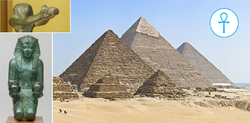- Retour accueil
- Vous êtes ici : Blog The Pyramids of the Cold The Pyramids of the Cold Section 13 • The Scarab Amulets
The Pyramids of the Cold Section 13 • The Scarab Amulets
Publié par Bruno Coursol dans The Pyramids of the Cold le 12/04/2022 à 20:06
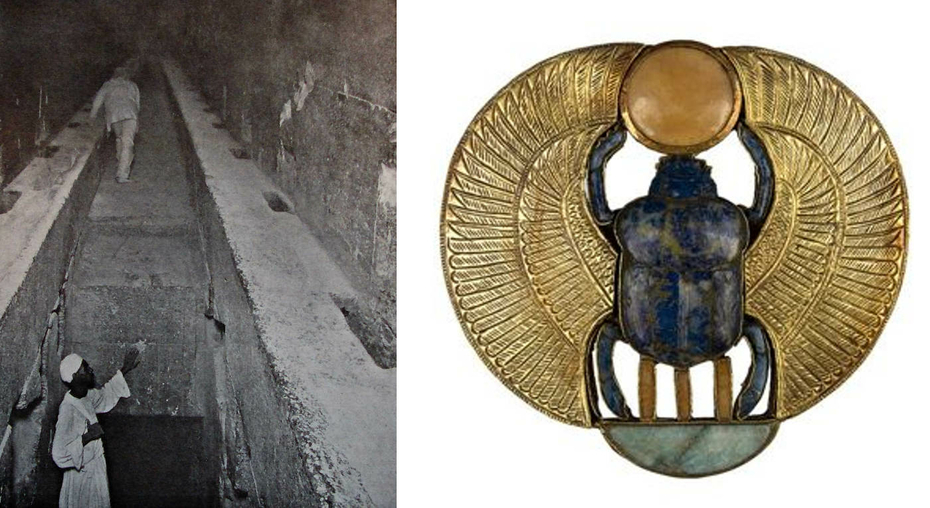
Pectoral of Tutankhamun with the Winged Scarab, thanks to http://www.globalegyptianmuseum.org/detail.aspx?id=14836
The Pyramids of the Cold - Section 13 • The Scarab Amulets
In summary : ancient Egyptian amulets in the form of beetle scarabs are glorifying representations of the Hauling Beetle of the Great Pyramid of Giza. The same way the Hauling Beetle was giving life to the pyramid, the scarab amulets were placed on the bodies of deceased people because they would have been able to give life back to them.
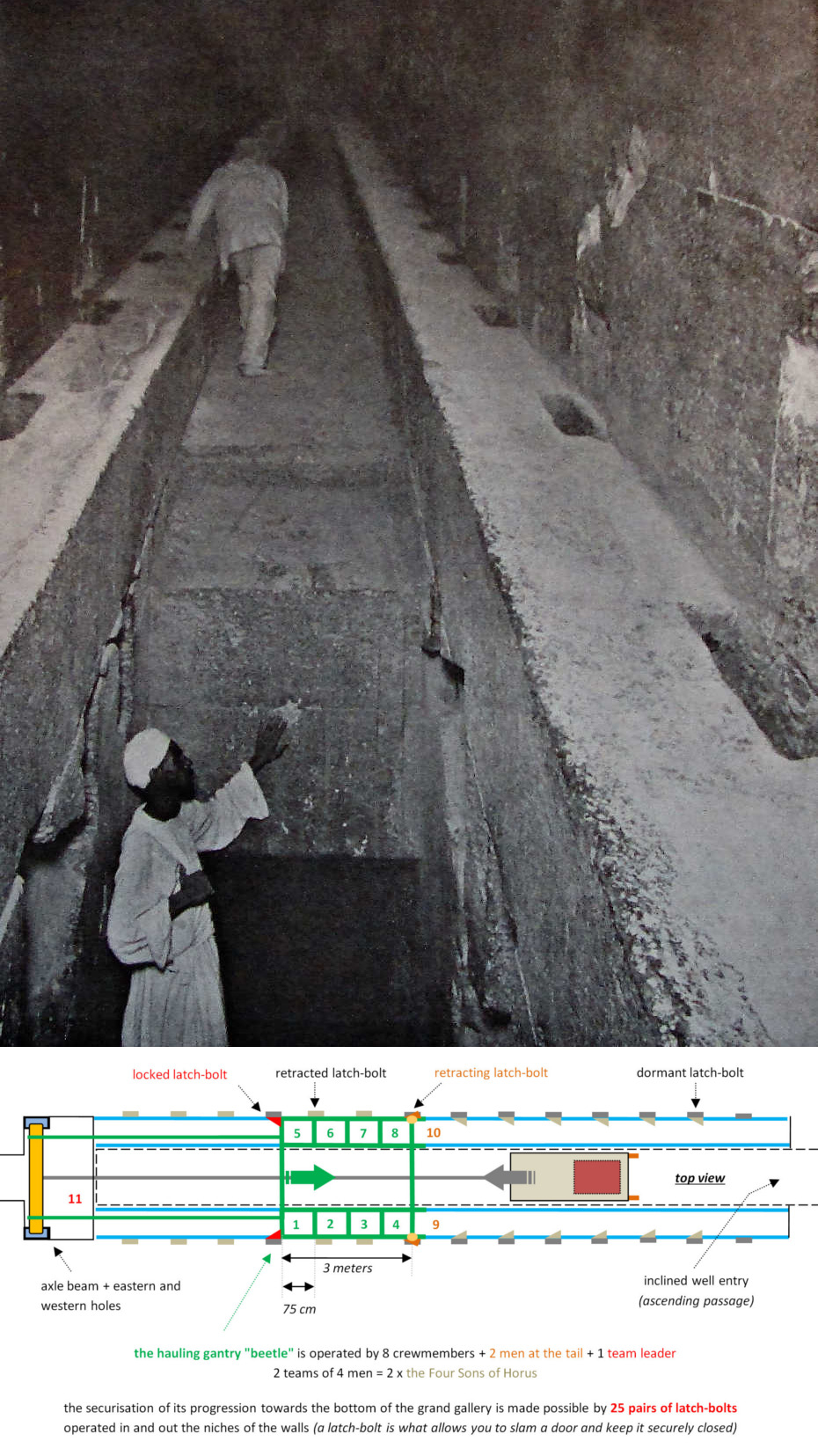
13.01 The similarities between the Hauling Beetle and the beetle scarab
At the beginning of my study on the Great Pyramid of Giza, I imagined a wooden gantry that was operated inside the Grand Gallery : the beetle. That beetle was in charge of constantly lifting an impactor, in order to create cold inside the horizontal passage and store it inside the Queen's chamber, most probably to be used through its shafts for cooling down chemical reactions for the manufacturing of sodium carbonate, the pure mineral form of natron, the salt used for the mummification of pharaohs.
I called that wooden gantry "the beetle", because I thought it would have look exactly like a real beetle scarab : the gantry had to be operated backwards, like a scarab rolling his ball of dung.
But it was nothing serious at the time, it was just based on look-alike elements and I didn't think at all about the scarab amulets.
Since I started to work on the ancient Egyptian scarab amulets though, I had to change my mind on the subject, because it really turns out that the scarab amulets are referring to the wooden beetle of the Great Pyramid of Giza.
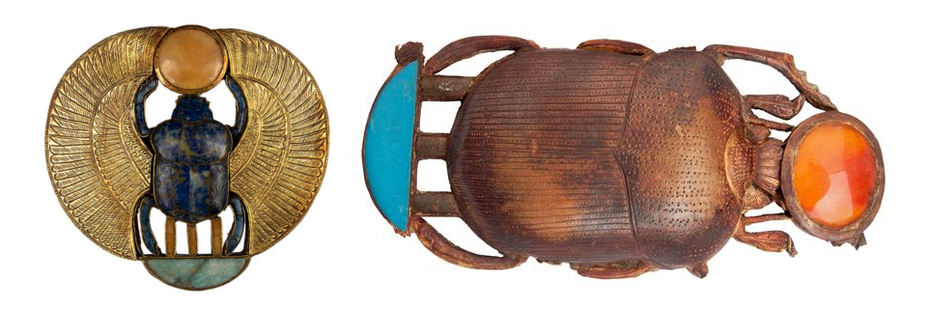
Ancient Egyptian scarab amulets showing on their lower part the 3 ropes that were operated by the Hauling Beetle, the wooden gantry that the amulets are referring to.
13.02 The first key element about the scarab animal is backwards : it is moving the dung ball backwards
The Great Pyramid of Giza was a master piece of engineering and it would have make a lot of noise and would have appear like a living animal. And what gave life to it, was the working crew inside the Grand Gallery, operating the Hauling Beetle.
To pull the impactor upwards, the Hauling Beetle crewmembers had to move backwards, because it is the position where you can give the maximum power, like you do when you are playing with a tug of war rope.
Because the Beetle gave life to the pyramid, and because the crewmembers were moving backwards, the whole thing would have look like a giant scarab moving his dung ball, backwards, the crew members looking like the scarab legs.
The important thing here, with the scarab, is not the dung ball he is rolling, but the fact that he is rolling it backwards. To my knowledge, the scarab is the only living animal moving backwards.
If you want to compare the operating of the wooden gantry to an animal, then you have no other choice than use the scarab.
13.03 The second key element about the amulet are the 3 little parallel brown segments
If you look attentively to some of the scarab amulets, the complete ones, we can see 3 short and parallel brown lines on the lower part of the amulets. They are representing the 3 ropes that were attached to the wooden gantry Hauling Beetle. What is very interesting to point out is the color used for the 3 short segments, because in pretty much every scarab amulet, the colors are golden or vivid yellows, blues, greens and reds, but these segments are in a dull brownish color. That doesn't fit at all with the prettiness of the entire amulet.
But of course, if these 3 lines are representations of 3 natural fiber ropes, then it works. The brown color of the 3 short segments is exactly the color of a natural fiber rope.
13.04 The real meaning of the scarab amulet wings
We can try to give an explanation to these deployed wings, but maybe there is more than just one right.
If we look at the hauling process from the impactor point of view, nobody was touching it and it would have looked like it was flying. Thus, it would explain why some scarab amulets are represented with fully deployed wings.
Of course it could also be a reference to the Sokar falcon representations : then the wings would be referring to the latch bolts.

Group of Egyptian scarab amulet carvings. Thanks to AuctionZip.com
13.05 Why so many scarab amulets have a complete longitudinal drilled hole
Most ancient Egyptian scarabs were suspended from string, and wires or mounted in swivel rings ; so they were drilled along their longitudinal axis.
This feature is probably unique among traditional Egyptian amulets : the hole, most of the time half drilled from the top and half drilled from the bottom, crosses the entire length of the amulet and replicate the original scarab operation of the Great Pyramid that was passing over the central gutter of the grand gallery.
13.06 The academic explanation of the dung ball representing the Sun God Khepri
It will always baffle me that any people would accept the idea that a god, Sun god Ra Khepri, would be please to know that he is compared to a dung ball, like many people claim the meaning of the scarab is. I wouldn't like to be compared to a dung ball and you certainly wouldn't like it as well. Chances are Ra wouldn't have liked it very much.
13.07 The symbolism of the scarab amulets : giving life back
The scarab amulets are referring to the operating of the Grand Gallery of the Great Pyramid of Khufu, the same way that the Dendera Light bulbs are referring to the horizontal cooling passage of that same pyramid.
The wooden gantry Hauling Beetle of the Grand Gallery looked like and behaved like a scarab because it was moving backwards. It made the Great Pyramid alive, and so the scarab amulets, that refer to that Hauling Beetle, would give life back to the deceased persons.
The Hauling Beetle was the heart of the Great Pyramid, and the scarab amulets had to be placed where the heart would be for the afterlife to be possible in order to make the mummification process successful.
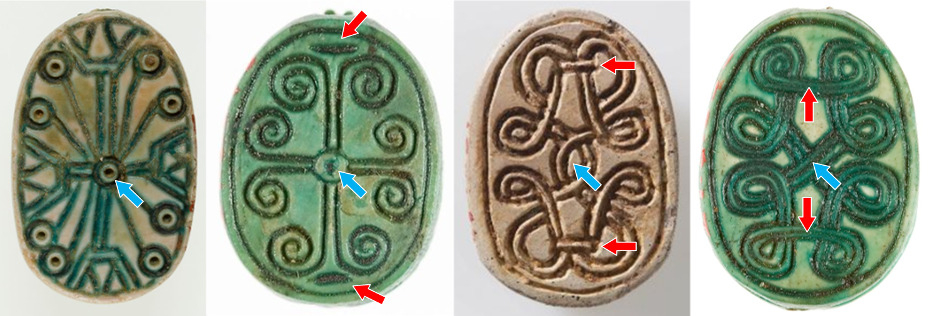
Ancient Egyptian scarab amulets from the Metropolitan Museum of Art, New-York : 1, 2, 3, 4
13.08 Are the scarab amulets circle and scroll decorations referring to the Hauling Beetle crewmembers ?
One of the many interesting things about the scarab amulets, is that they have all kinds of markings underneath them. Sometimes there are some hieroglyphs and sometimes there is nothing else than geometrical markings, like circles, buckles or scrolls.
If I'm right about the real meaning of scarab amulets, then probably these decorations are referring to the crewmen of the Hauling Beetle.
In a previous section of the study, we've seen that the Hauling Beetle of the Grand Gallery was operated by 8 crewmen : 4 crewmembers in the Western Hauling Beetle unit and 4 in the Eastern unit. 2 other men, one on each ramp were also operating the latch bolts and the ropes when they were disconnected to the impactor.
That makes 10 crewmen for the entire towing structure. But it would be difficult to imagine that a team leader wasn't there. That makes 11 team members involved in the operating of the Hauling Beetle, even if they don't have the same role or the same importance : maybe it would be more appropriate to talk about a team of 8 + 2 + 1.
Interestingly, many of the scarab amulets with these geometrical kind of decorations are showing 9 dots, 9 circles, 9 scrolls or 9 buckles, and they are arranged in 2 columns of 4, plus a central one, whether it is clearly marked by a dot and circle like on the 2 scarabs above on the left; or it is simply suggested by interlacing buckles or curls, like the 2 scarabs on the right (blue arrows).
Having that in mind, I think it is very possible that these particular 9 decorative elements are representations of 9 of the crewmen of the Hauling Beetle. The last amulet does even display 3 lines, exactly like the 3 ropes of the grand gallery.
If this hypothesis is correct, it would probably mean that the 9 crewmen would have been the 8 crewmembers who were inside the gantry, plus the team leader.
The 2 crewmembers out of the gantry would have been forgotten. Is it possible? These 2 crewmen did have a different role and a different importance in the team, but would it be enough not to show them in many scarabs?
Another thing is that some other scarab amulets don't seem to be "based" on the number 9 : scarab amulets based on the number 4, 8, 10, 11 or more also exist.
Of course for all these numbers, it is pretty easy to find an explanation based on the Hauling Beetle team, but some other scarabs have more than 11 decorative elements or only 2.
So does that mean that the hypothesis is incorrect ?
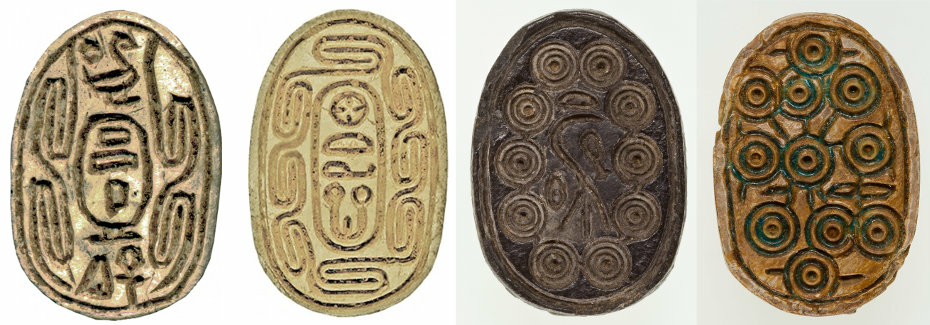
Photographs thanks to the Walters Art Museum, Baltimore USA : 1, 2, 3 4
13.09 The large variety of Hauling Beetles in ancient Egypt
It is clear that there is a large variety of scarab amulet decorations, based on all kinds of numbers, but does that mean that these numbers are actually not referring to the Hauling Beetle team?
I wouldn't be so sure. Because if there is a very large variety of scarab amulet decorations, maybe it also means that there was a large variety of Hauling Beetles.
I personally think that a vast amount of wooden beetles, with different designs, were used for the construction of the pyramids, and that the Hauling Beetle of the Grand Gallery is very unlikely to have been the only hauling gantry used during the operation of the Great Pyramid.
Some of them would be operated inside the pyramids, some of them outside ; and with a varying number of crewmembers.
If the beetle of the Grand Gallery was really designed in 2 parts, 2 narrow independent beetles of 4 crewmen and connected together, then probably this kind of unit could have been used in the descending passage of the Great Pyramid and in many other locations.
Probably single, double or even triple units of this kind could have been used outside the pyramids in particular for the Great Pyramid in order to operate the natron production unit, starting with the limestone supply of the kiln.
Maybe the 3 x 3 design of the 9 prisoners scarab amulet depict precisely this particular approach.
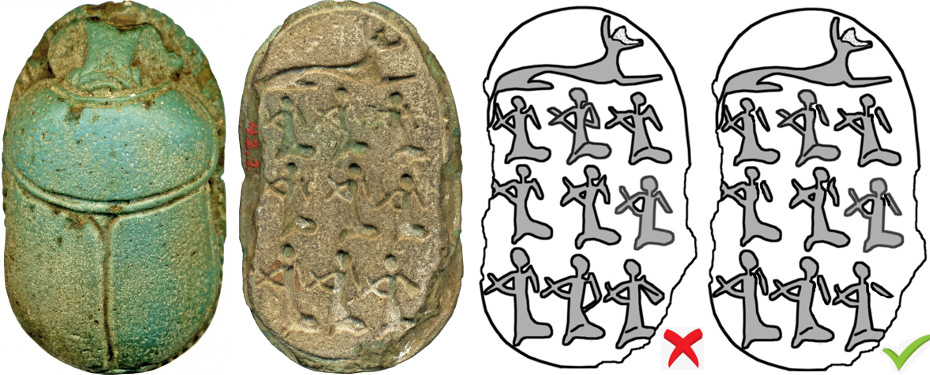
The 9 prisoners scarab amulet, thanks to the Walters Art Museum, 1330-1213 BCE (New Kingdom, Dynasty 18). Wonderful site, where you can zoom as much as you want on any photograph.
13.10 Were the crewmembers of the Hauling Beetle captive prisoners?
The conventional interpretation of these 9 characters, is that they are prisoners, with their hands tied up behind their backs. But then there is a problem, because if these 9 characters are referring to the Hauling Beetle of the Grand Gallery, then it would mean that the crewmembers of the Beetle were prisoners.
The question is, would ancient Egyptians have carved prisoner representations onto such important amulets that they would have honor and worship ?
Honestly it is hard to believe. But on the other hand, the work conditions would have been excruciating, because if the goal was to cool the temperature of the Queen's chamber, down to 5°C or 10°C (41°F or 50°F) and maintain this low temperature over time, it means that the Grand Gallery and the Hauling Beetle would have to be in operation for days, weeks or even months, without ever stopping.
The use of captive prisoners in these conditions could have been simply unavoidable.

13.11 The backrest / handrails of the wooden Hauling Beetle
This amulet does show 9 characters, but I disagree with the drawing interpretation that has been made regarding the 9 elements appearing in front of the character's shoulders : none of them is connected to the character's bodies.
You can verify that by yourself, using the zoom application directly at the Walters Art Museum site, here : https://art.thewalters.org/detail/3485/
In fact, we surely can assume that these 9 elements had been originally drawn with a perfectly neat sharp-edged shape, like the one shown on the second photograph above, with the red pointing arrow, next to the third character.
In my opinion, and if my interpretation of the scarab amulets is correct, what these 9 characters have in front of their shoulders, perfectly detached from their bodies and with a perfectly geometrical sharp-edged shape, are the backrest / handrails of the Hauling Beetle they got right in front of them, just a few centimeters from their heads.
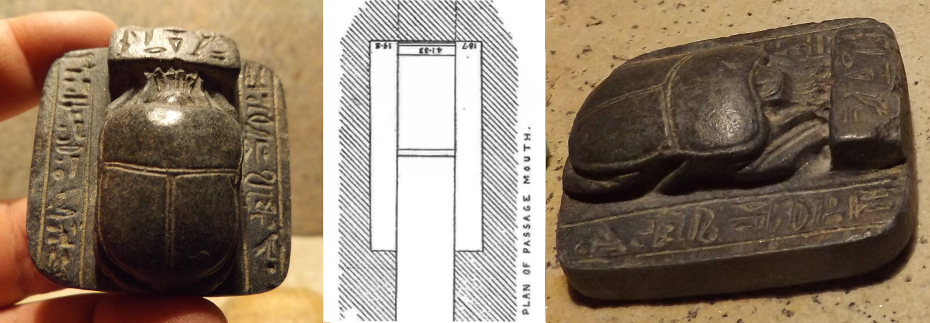
Special gratitude to Kameron, from downunderpharaoh.com for the use of his photographs of the squared scarab amulet. In the center, the "plan of passage mouth", from the "trial passages" tunnels of the Great Pyramid of Khufu at Giza.
13.12 The The scarab amulet in a squared shape set replica of the grand gallery
That particular squared shape make this scarab amulet very special, because it probably puts the scarab within the exact layout of the grand gallery of the Great Pyramid of Khufu.
The 2 lateral ramps of the grand gallery are 1 cubit width and the central gutter is 2 cubits width ; and these proportions are exactly the same as the ones we find on this squared amulet.
The scarab is most probably represented at the bottom of the grand gallery. There are of course 2 exceptions to the realistic design of this amulet : the wooden scarab wasn't inside the gutter but on both sides of it, moving onto the 2 lateral ramps ; and there was no block in the middle of the gutter either.
Probably, that the transversal block with the hieroglyphs in front of the scarab beetle, stands for the north wall of the gallery, where the wooden beetle would have to rest after its descent in order to get ready to climb up again the slope.
Another thing is that this amulet could confirm the idea I got from the Tutankhamun Senet game table, that the wooden scarab of the gallery wasn't just a unique structure with 2 sledge runners, one against each wall, but 2 narrow structures like the Senet game table. These 2 beetles wouldn't even have to be linked together, they would have been completely independent.
Is this configuration realistic in regards to the necessary team coordination between the 2 beetles? Would it be the main reason for a team leader that would have stayed permanently on the top platform of the grand gallery ?
Nethertheless, on that squared scarab, we can notice that the 2 lateral parts are marked with 2 vertical and parallel straight lines, framing the hieroglyphs and that the hieroglyphs of the top horizontal part have no line at all to frame them.
These 4 vertical lines could be a reference to the 4 hollow-section rails of the grand gallery.
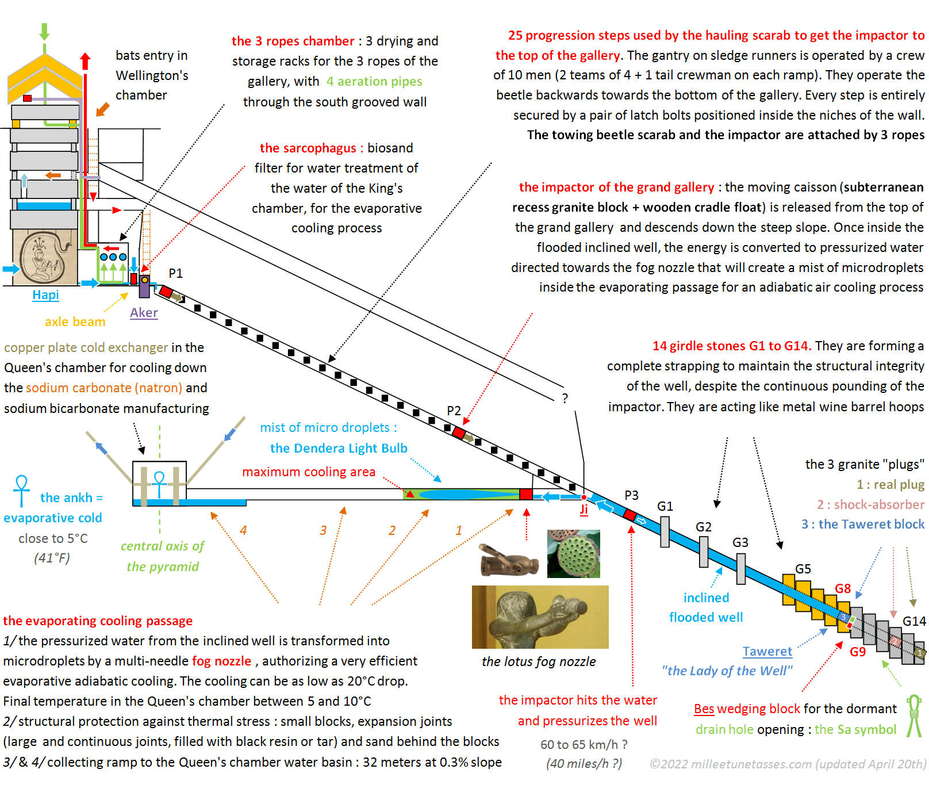
Diagram of the Great Pyramid of Giza in operation, before the shutdown procedure and the draining of the inclined well.
13.13 Summary of the study : hidden behind the academic vision of the ancient Egyptian religion, a vast number of metaphors are describing some of the most advanced science and technological knowledge of that time : ancient Egyptian gods were nothing else than pharaohs' metaphoric self-glorifications of their theoretical and experimental scientific accomplishments in physics and chemistry.
Pharaohs used the power of Science to legitimate themselves as kings of Egypt : they forged an entire religion, based on science to rule their kingdom, and they presented that science as Magic.
The end game of this technological program that probably started on the very first Dynasty, was the Great Pyramid of Giza where evaporative cooling was engineered in the known part of the pyramid from the pressurized water produced in the inclined well, known today as the ascending passage.
The evaporative cold simply took advantage of the power of water, and was most probably necessary to cool down chemical manufacturing of sodium carbonate and sodium bicarbonate produced by an ammonia-soda Solvay process, as suggested by the very strong ammonia smell and the limestone kiln in the so-called burial chamber of the Red Pyramid. At that time, sodium carbonate was called natron, and it was the salt used for the mummification of the pharaohs (Sections 14, 15 and 16).
The cooling seems to have represented the most difficult part of the process, as suggested by the Step Pyramid's official name : according to scholars, the very first pyramid complex, the Step Pyramid of Djoser, was called "the refreshment of the Gods". No doubt that a more accurate translation would certainly be "the cooling of the Gods".
It means that ancient Egyptians were the first civilization to master a Solvay-like process for sodium carbonate manufacturing, long before it got reinvented in the 1800's in Europe. The key elements of that process is the temperature control of the chemical reactions (the cooling), and the dome shaped plate necessary for the counterflow chemical reactions to occur in an efficient way. That counterflow reaction plate is what really is the disc of Sabu.
As shown with Akhenaten and Nefertiti, the creation of the evaporative cold was the most sacred accomplishment of all (Section 17), and this is exactly what the Dendera Light is all about : the Dendera Light is the fog of microdroplets of liquid water that evaporates and creates the cold. Talking about the snake inside the Dendera Light Bulb : "The field surrounding Ra’s snake form is referred to in ancient Egyptian literature as protective magical energy in liquid form that all gods and pharaohs possess" (Faulkner, Section 2).
Everything that had been done in the Great Pyramid of Giza inspired most of the ancient Egyptian religion, and it had been glorified into what we know today as the Underworld.
The Underworld is referring to the chambers and passages of the Great Pyramid of Khufu, and in particular to the Grand Gallery where a hauling gantry beetle operated a wooden coffin shaped impactor that had a small nested granite block inside it. The impactor generated endlessly, over and over, maybe every 15 minutes the pressurized water that was then transformed into a fog of microdroplets inside the horizontal cooling passage.
The Grand Gallery of the Great Pyramid where the act of hauling was done, is the "Secret Hauling Cavern of the Underworld" described in the Amduat "Book of the Hidden Chamber".
The most important chamber of the Great Pyramid wasn't the King's chamber that only was the main water tank of the pyramid, but the Queen's chamber, the only one on the central axis of the pyramid. Because the Queen's chamber was inaccessible from the rest of the pyramid, it was glorified into the "Hidden Chamber of the Underworld" (Section 11), and because the Queen's chamber was the coolest place in the pyramid (about 5°C / 41°F), and with a constant 100% Humidity rate, this chamber was the one where the biggest amount of very hard salt encrustation had been documented by the first explorers of the pyramid in the 1800's and before it had been removed in 1998 by Zahi Hawass (Section 1). Very hard salt encrustation is the signature of the evaporative cooling process, even nowadays.
The most incredible thing is that pretty much everything I've just said, actually appears in one single myth, but it doesn't originate from ancient Egypt : it is the "Churning of the Ocean" Hindu myth that produces the immortal nectar Amrita. The fact is that the endless churning of water that ends up with the production of an elixir that gives eternal life, is exactly what were doing ancient Egyptians in the inclined well : natron was the salt used for the mummification of pharaohs.
Natron gave eternal life to pharaohs, just like the Amrita (Section 19).
Sheryl Crowe
CONGRATULATIONS!!!!
You've solved it!!!
Poster un commentaire

